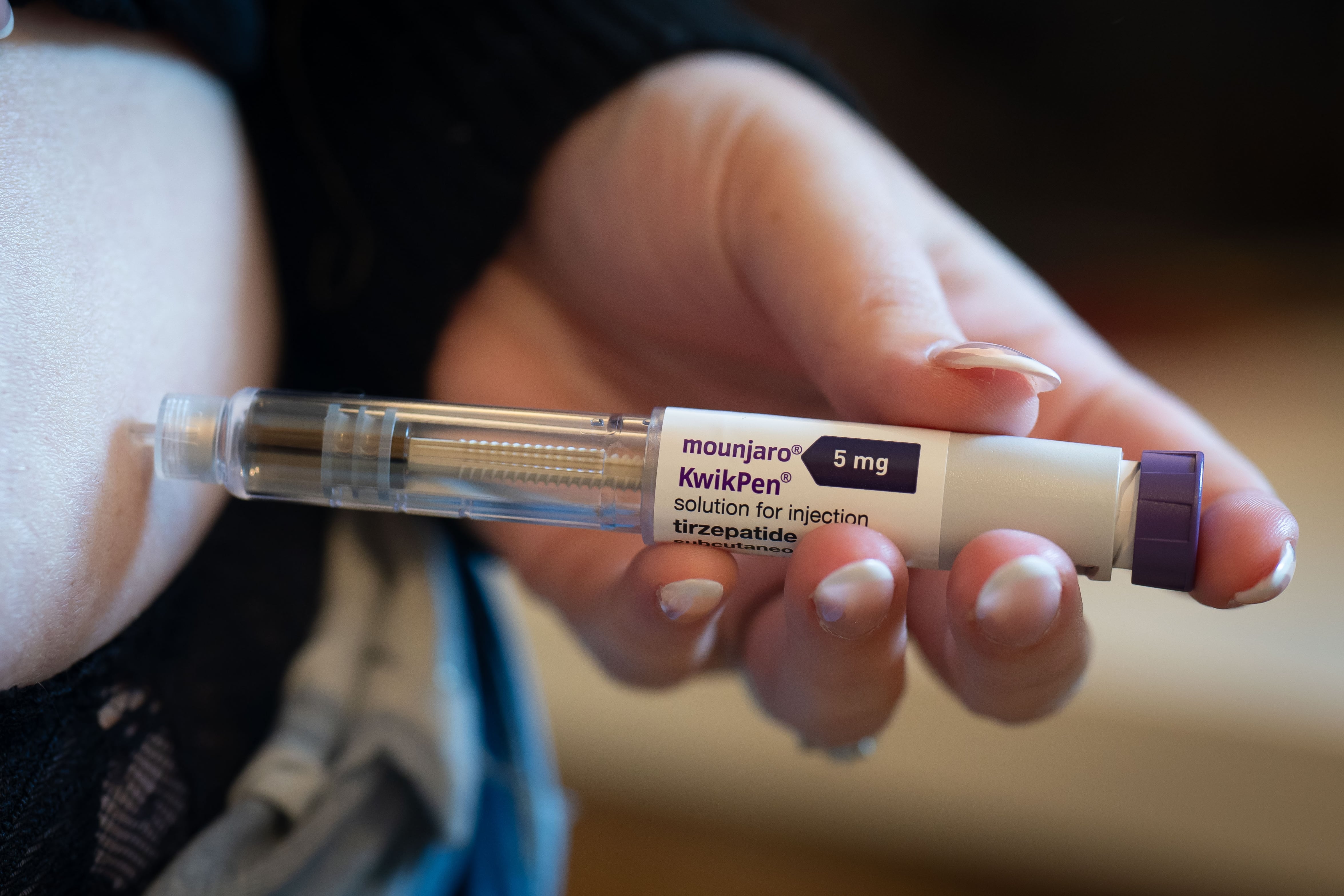Public health, explained: Sign up to receive Healthbeat’s Global Checkup in your inbox a day early.
Hello from Nairobi.
This week’s stories zigzag across global health: money chasing weight loss, the heartbreak behind a potential Ebola victory, governments stuck on repeat, and scientists quietly pushing the boundaries of what medicine can conquer. Still, think I’m missing something big? Email me!
My name is William Herkewitz, and I’m a journalist based in Nairobi, Kenya. This is the Global Health Checkup, where I highlight five of the week’s most important stories on outbreaks, medicine, science, and survival from around the world.
With that, as we say in Swahili: karibu katika habari — welcome to the news.
The risk of slimmer margins
An economic gold rush is rippling through global health, and it’s powered by GLP-1 weight-loss drugs.
In just the past week, Reuters reports that pharma giant Eli Lilly’s injectable GLP-1 weight-loss drug Mounjaro became India’s top-selling drug, overtaking antibiotics that have long dominated the market. At the same time, the corporation announced a new, $3 billion plant in the Netherlands to mass-produce a new pill form of the drug, a sign that the market is expected to grow significantly faster than existing factories can keep up. (The Financial Times has an excellent story on the scientific and economic race to make these new pills; I have a syndicated, non-paywalled link here.)
- Background: GLP-1 drugs like Mounjaro, Wegovy, and Ozempic mimic a natural hormone that regulates blood sugar and appetite. Essentially, the medicine signals fullness to your brain and slows down digestion. The “GLP-1” name is an abbreviation for the molecule it mimics, which was originally developed as a treatment for diabetes.
My big question here: Is this a zero-sum boom?
Global health aid is shrinking, so as factories ramp up to make billions of GLP-1 pills, are they pulling resources away from other essential medicines? I reached out to Prashant Yadav at the Council on Foreign Relations, who is one of the foremost authorities on global drug manufacturing.
There is indeed a drug-shortage risk, says Yadav, albeit a narrow one. To understand why this is, first you have to know two things about GLP-1 drugs, and what makes the pills different from injectables.
First: Unlike say, aspirin, GLP-1 drugs don’t just require cooking up inert chemicals in a lab. Instead, as part of their manufacturing process, they involve corralling living creatures. In particular, coaxing a genetically tweaked beer yeast — yes, this is true! — to produce molecules. Importantly, this is also how insulin is made.
Second: The pills require a lot more of the active compound than the injection. About three to four times more, says Yadav. The reason why isn’t complicated … it’s basically because your gut destroys most of what you swallow.
Combine these factors, and you could get a classic market squeeze: limited manufacturing capacity chasing the highest profit margin. “This shift could ultimately put pressure on the global insulin supply, particularly in developing countries,” Yadav says.
But Yadav says I’m missing the bigger issue. Shortages are not a sure thing, but the fight over who gets access to these drugs is already here. About two-thirds of the world’s 1 billion obese adults live outside the developed world, and Yadav says the real question is whether or how people in “India, Mexico, Nigeria, South Africa, the Philippines, and other countries” with sizable obese populations will get these same medicines.
And as the new pills are deployed, that’s where to watch.
A window into the Ebola outbreak
We’ve been following the Ebola outbreak in the Democratic Republic of the Congo, where just a few days after our last check-in, the World Health Organization declared that responders discharged a (potentially) final patient.
That restarted the official countdown (42 days, which is twice the incubation period of the virus) for the outbreak to be declared over. Materially, not much has changed since our last update, which Dr. Paul Spiegel, director of the Johns Hopkins Center for Humanitarian Health, called “promising and precarious.” Promising, because the speed and effectiveness of the response bucked the worst-case fears that we’d lost the money and muscle to contain such a crisis. And precarious because, as I wrote then, we’re relying on a new world of “reactive, one-off appeals that pull resources from other crises” rather than steady support.
Why the update? Because The Guardian just published a deeply reported snapshot of what that response looked like up close, largely told through one man’s story. The piece is worth the full read: For me, it transformed an abstract story about case counts and funding gaps into a vivid, human window into the outbreak.
I’ll try not to ruin the story, but it follows Bope Mpona Héritier, an Ebola survivor from the remote village of Bulape who “lost his wife, daughter and mother” before realizing he was infected, too. Inside his isolation tent, Héritier remembers, “there were three other patients. I watched them all die, one by one.”
It’s heartbreaking, of course. But what stood out most was how the story reveals what responders actually mean when they talk about the challenges of vaccinating, tracing, and operating in “hard to reach” areas … and how that same isolation became a quiet blessing in slowing the spread. “It took some of us four days to reach Bulape from the capital, Kinshasa, because we had to cross forests,” recalls Chiara Montaldo of Médecins Sans Frontières. (For reference: These locations are only about 430 miles apart, about the same distance between Chicago and Atlanta, or Paris and Berlin). And “we had to bring everything from outside, including medicines, materials for building tents, and water decontamination supplies.”
The price tag to preempt the next pandemic
I don’t know about you, but I loathe talking about the Covid-19 pandemic. For me, the topic dredges memories of isolation and social distancing, anxiety, and those mean little nasal swabs … and ultimately still getting walloped by the virus three times. (Honestly, I usually try to change the subject when it comes up.)
So I find it a little odd that this next story — which starts with the upsetting news that scientists estimate there’s roughly a 50-50 chance the world will face another global pandemic in the next 25 years — is actually rather empowering.
Writing in Vox, Stephanie Psaki, who served as the first U.S. coordinator for global health security under the Biden administration, argues that the next pandemic isn’t by any means inevitable. In fact, “scientific and medical advances have made it possible to detect, treat, and stop the pathogens most likely to sweep across continents and cause widespread death” in perpetuity within the next 10 years, she says.
Psaki does not float this flippantly. In a long but impressively methodical essay, she lays out exactly what’s needed over the next decade: The steps to reduce the odds of a virus ever jumping from animals to humans. Then how to build the kind of global surveillance and rapid diagnostic capacity that can catch outbreaks early. And how we can use existing tech to develop vaccine and drug platforms that can be tailored to a new pathogen within weeks.
What makes Psaki’s argument so striking is its practicality and specificity. She even gives a price tag.
“Conservatively … $30 billion annually” over a decade could be enough, she writes, “to take the top pandemic threats off the table.”
Bangladesh’s annual dengue lesson, still unlearned
Bangladesh is months into a crisis of dengue virus, one that health experts warned in October was “worsening rapidly with infections and deaths climbing sharply across the country.” They cautioned the disease could spiral if urgent and coordinated mosquito control efforts were not launched. That spiral now appears to be happening, the WHO reports.
- Disease breakdown: Dengue is a millennia-old mosquito-born virus that’s sometimes called “break-bone fever” for the intense joint and muscle pain it causes. Although it has a very low fatality rate (less than 1%), it spreads quickly through mosquitoes that thrive in cities. That makes it extremely difficult to wall off and allows outbreaks to balloon to millions of cases.
To put today’s crisis in perspective: Dengue cases in Bangladesh are tracking close to the country’s devastating 2022 and 2024 outbreaks, which were the second and third worst years on record. It’s still not nearly as catastrophic as the record-setting 2023 epidemic (which had four times more cases than any other year on record) but hospitals are once again overwhelmed as the virus spreads beyond the capital city Dhaka into rural districts.
The question: Why is this happening again?
You can place part of the blame on warmer temperatures and heavier monsoon rains, which are both intensified by climate change and are expanding the mosquito breeding seasons. You can also lay blame on newly endemic mosquito species. But in an absolutely blistering op-ed in Bangladesh’s independent newspaper New Age, political columnist M.A. Hossain argues the real cause isn’t nature, it’s political negligence.
He accuses local authorities of repeating the same cycle of inaction every year: slow mosquito control, poor drainage, and a lack of political accountability until the crisis peaks. His essay lands less as commentary and more as an open-handed scolding.
In his words, “mosquitoes have become symbols of our administrative failure.” Hossain writes that despite years of warnings, “city authorities act only when the situation turns dire,” and that the government’s seasonal clean-up drives have become “a yearly ritual of denial and blame.”
His conclusion: “Dengue has not defeated us. We have defeated ourselves by refusing to learn.”
Immune system, meet self-control
We’ll end the week with something genuinely promising. The Associated Press just published a pair of powerful stories on autoimmune diseases: the broad, 100+ family of poorly understood conditions caused when the body begins attacking itself. That family includes lupus, type-1 diabetes, multiple sclerosis, and rheumatoid arthritis. Like the Ebola coverage earlier, the AP reporting really zooms in on the lived experience of people navigating those illnesses.
Why is this hopeful? Because, as New York University Langone rheumatologist Dr. Amit Saxena put it, “this is probably the most exciting time that we’ve ever had to be in autoimmunity” research.
As the story reports, researchers are using new tools and “discoveries from cancer research and the Covid-19 pandemic” vaccines to decoding the wiring “behind these debilitating illnesses.” While some treatments are moving faster than others, researchers are increasingly uncovering links between diseases once thought unrelated and testing new ways to bolster the immune system.
One such experimental treatment retrains immune cells instead of merely suppressing them, and is called CAR-T therapy. How it works is wild: Researchers extract a patient’s immune cells, splice the cells’ DNA to add a new gene that helps them recognize a specific threat, and then infuse them back into the body by the millions. “The first lupus patient was treated in Germany [with CAR-T therapy] in March 2021 and remains in drug-free remission, the researchers said last month.”
I’ll see you next week!
William Herkewitz is a reporter covering global public health for Healthbeat. He is based in Nairobi. Contact William at wherkewitz@healthbeat.org.






